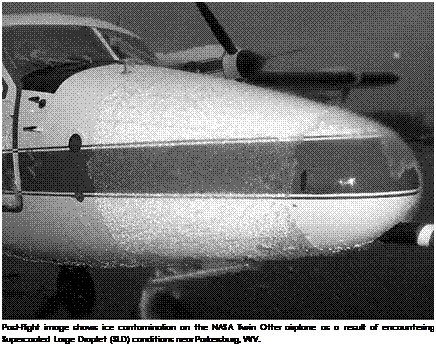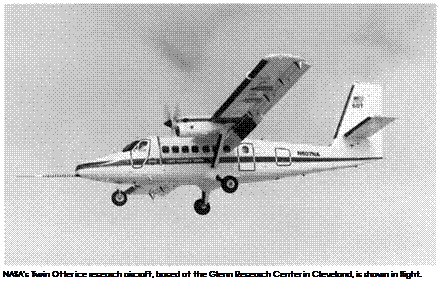Learning to Fly with SLDs
From the earliest days of aviation, the easiest way for pilots to avoid problems related to weather and icing was to simply not fly through clouds or in conditions that were less than ideal. This made weather forecasting and the ability to quickly and easily communicate observed conditions around the Nation a top priority of aviation researchers. Working with the National Oceanic and Atmospheric Administration (NOAA) during the 1960s, NASA orbited the first weather satellites, which began equipped with black-and-white television cameras and
 |
|
have since progressed to include sensors capable of seeing beyond the range of human eyesight, as well as lasers capable of characterizing the contents of the atmosphere in ways never before possible.[1248]
Our understanding of weather and the icing phenomenon, in combination with the latest navigation capabilities—robust airframe manufacturing, anti – and de-icing systems, along with years of piloting experience—has made it possible to certify airliners to safely fly through almost any type of weather where icing is possible (size of the freezing rain is generally between 100 and 400 microns). The exception is for one category in which the presence of supercooled large drops (SLDs) are detected or suspected of being there. Such rain is made up of water droplets that are greater than 500 microns and remain in a liquid state even though its temperature is below freezing. This makes the drop very unstable, so it will quickly freeze when it comes into contact with a cold object such as the leading edge of an airplane. And while some
of the SLDs do freeze on the wing’s leading edge, some remain liquid long enough to run back and freeze on the wing surfaces, making it difficult, if not impossible, for de-icing systems to properly do their job. As a result, the amount of ice on the wing can build up so quickly, and so densely, that a pilot can almost immediately be put into an emergency situation, particularly if the ice so changes the airflow over the wing that the behavior of the aircraft is adversely affected.
![]() This was the case on October 31, 1994 when American Eagle Flight 4184, a French-built ATR 72-212 twin-turboprop regional airliner carrying a crew of 4 and 64 passengers, abruptly rolled out of control and crashed in Roselawn, IN. During the flight, the crew was asked to hold in a circling pattern before approaching to land. Icing conditions existed, with other aircraft reporting rime ice buildup. Suddenly the ATR 72 began an uncommanded roll; its two pilots heroically attempted to recover as the plane repeatedly rolled and pitched, all the while diving at high speed. Finally, as they made every effort to recover, the plane broke up at a very low altitude, the wreckage plunging into the ground and bursting into flame. An exhaustive investigation, including NASA tests and tests of an ATR 72 flown behind a Boeing NKC-135A icing tanker at Edwards Air Force Base, revealed that the accident was all the more tragic for it had been completely preventable. Records indicated that the ATR 42 and 72 had a marked propensity for roll-control incidents, 24 of which had occurred since 1986 and 13 of which had involved icing. The National Transportation Safety Board (NTSB) report concluded:
This was the case on October 31, 1994 when American Eagle Flight 4184, a French-built ATR 72-212 twin-turboprop regional airliner carrying a crew of 4 and 64 passengers, abruptly rolled out of control and crashed in Roselawn, IN. During the flight, the crew was asked to hold in a circling pattern before approaching to land. Icing conditions existed, with other aircraft reporting rime ice buildup. Suddenly the ATR 72 began an uncommanded roll; its two pilots heroically attempted to recover as the plane repeatedly rolled and pitched, all the while diving at high speed. Finally, as they made every effort to recover, the plane broke up at a very low altitude, the wreckage plunging into the ground and bursting into flame. An exhaustive investigation, including NASA tests and tests of an ATR 72 flown behind a Boeing NKC-135A icing tanker at Edwards Air Force Base, revealed that the accident was all the more tragic for it had been completely preventable. Records indicated that the ATR 42 and 72 had a marked propensity for roll-control incidents, 24 of which had occurred since 1986 and 13 of which had involved icing. The National Transportation Safety Board (NTSB) report concluded:
The probable cause of this accident were the loss of control, attributed to a sudden and unexpected aileron hinge moment reversal that occurred after a ridge of ice accreted beyond the deice boots because: 1) ATR failed to completely disclose to operators, and incorporate in the ATR 72 airplane flight manual, flightcrew operating manual and flightcrew training programs, adequate information concerning previously known effects of freeing precipitation on the stability and control characteristics, autopilot and related operational procedures when the ATR 72 was operated in such conditions; 2) the French Directorate General for Civil Aviation’s (DGAC’s) inadequate oversight of the ATR 42 and 72, and its failure to take the necessary corrective action to ensure continued
airworthiness in icing conditions; and 3) the DGAC’s failure to provide the FAA with timely airworthiness information developed from previous ATR incidents and accidents in icing conditions, as specified under the Bilateral Airworthiness Agreement and Annex 8 of the International Civil Aviation Organization.
![]() Contributing to the accident were; 1) the Federal Aviation Administration’s (FAAs) failure to ensure that aircraft icing certification requirements, operational requirements for flight into icing conditions, and FAA published aircraft icing information adequately accounted for the hazards that can result from light in freezing rain and other icing conditions not specified in 14 Code of Federal Regulations 9CFR) part 25, Appendix C; and 2) the FAA’s inadequate oversight of the ATR 42 and 72 to ensure continued airworthiness in icing conditions. [1249]
Contributing to the accident were; 1) the Federal Aviation Administration’s (FAAs) failure to ensure that aircraft icing certification requirements, operational requirements for flight into icing conditions, and FAA published aircraft icing information adequately accounted for the hazards that can result from light in freezing rain and other icing conditions not specified in 14 Code of Federal Regulations 9CFR) part 25, Appendix C; and 2) the FAA’s inadequate oversight of the ATR 42 and 72 to ensure continued airworthiness in icing conditions. [1249]
This accident focused attention on the safety hazard associated with SLD and prompted the FAA to seek a better understanding of the atmospheric characteristics of the SLD icing condition in anticipation of a rule change regarding certifying aircraft for flight through SLD conditions, or at least long enough to safely depart the hazardous zone once SLD conditions were encountered. Normally a manufacturer would demonstrate its aircraft’s worthiness for certification by flying in actual SLD conditions, backed up by tests involving a wind tunnel and computer simulations. But in this case such flight tests would be expensive to mount, requiring an even greater reliance on ground tests. The trouble in 1994 was lack of detailed understanding of SLD precipitation that could be used to recreate the phenomenon in the wind tunnel or program computer models to run accurate simulations. So a variety of flight tests and ground-based research was planned to support the decisionmaking process on the new certification standards.[1250]
![]()
 |
One interesting approach NASA took in conducting basic research on the behavior of SLD rain was to employ high-speed, close-up photography. Researchers wanted to learn more about the way an SLD strikes an object: is it more of a direct impact, and/or to what extent does the drop make a splash? Investigators also had similar questions about the way ice particles impacted or bounced when used during research in an icing wind tunnel such as the one at GRC. With water droplets less than 1 millimeter in diameter and the entire impact process taking less than 1 second in time, the close-up, high-speed imaging technique was the only way to capture the sought-after data. Based on the results from these tests, follow-on tests were conducted to investigate what effect ice particle impacts might have on the sensing elements of water content measurement devices.[1251]
Another program to understand the characteristics of SLDs Supercooled Large Droplets involved a series of flight tests over the Great Lakes during the winter of 1996-1997. GRC’s Twin Otter icing research aircraft was flown in a joint effort with the FAA and the National Center for Atmospheric Research (NCAR). Based on weather forecasts
and real-time pilot reports of in-flight icing coordinated by the NCAR, the Twin Otter was rushed to locations where SLD conditions were likely. Once on station, onboard instrumentation measured the local weather conditions, recorded any ice accretion that took place, and registered the aerodynamic performance of the aircraft in response to the icing. A total of 29 such icing research sorties were conducted, exposing the flight research team to all the sky has to offer—from normal-sized precipitation and icing to SLD conditions, as well as mixed phase conditions. Results of the flight tests added to the database of knowledge about SLDs and accomplished four technical objectives that included characterization of the SLD environment aloft in terms of droplet size distribution, liquid water content, and measuring associated variables within the clouds containing SLDs; development of improved SLD diagnostic and weather forecasting tools; increasing the fidelity of icing simulations using wind tunnels and icing prediction software (LEWICE); and providing new information about SLD to share with pilots and the flying community through educational outreach efforts.[1252]
![]() Thanks in large measure to the SLD research done by NASA in partnership with other agencies—an effort NASA Associate Administrator Jaiwon Shin ranks as one of the top three most important contributions to learning about icing—the FAA is developing a proposed rule to address SLD icing, which is outside the safety envelope of current icing certification requirements. According to a February 2009 FAA fact sheet: "The proposed rule would improve safety by taking into account supercooled large-drop icing conditions for transport category airplanes most affected by these icing conditions, mixed-phase and ice-crystal conditions for all transport category airplanes, and supercooled large drop, mixed phase, and ice-crystal icing conditions for all turbine engines.”[1253]
Thanks in large measure to the SLD research done by NASA in partnership with other agencies—an effort NASA Associate Administrator Jaiwon Shin ranks as one of the top three most important contributions to learning about icing—the FAA is developing a proposed rule to address SLD icing, which is outside the safety envelope of current icing certification requirements. According to a February 2009 FAA fact sheet: "The proposed rule would improve safety by taking into account supercooled large-drop icing conditions for transport category airplanes most affected by these icing conditions, mixed-phase and ice-crystal conditions for all transport category airplanes, and supercooled large drop, mixed phase, and ice-crystal icing conditions for all turbine engines.”[1253]
As of September 2009, SLD certification requirements were still in the regulatory development process, with hope that an initial, draft rule would be released for comment in 2010.[1254]










